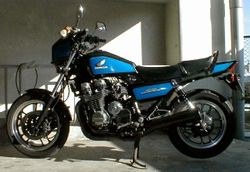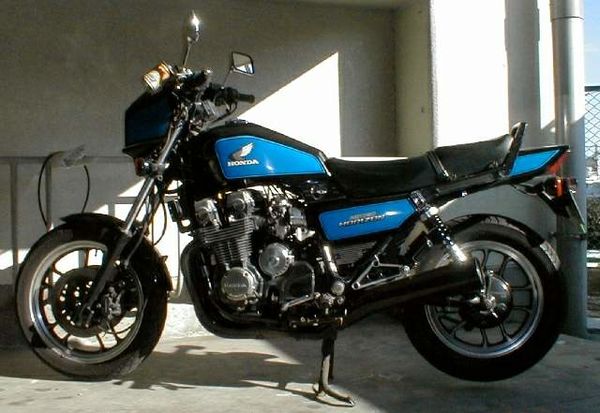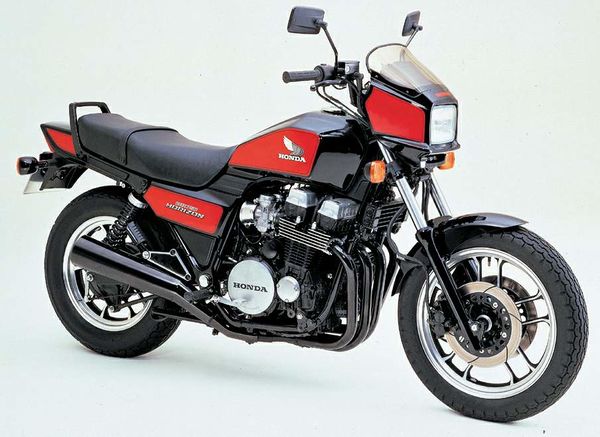Difference between revisions of "Honda CBX750 Horizon"
(template fixes) |
|||
| Line 14: | Line 14: | ||
|compression = 9.3:1 | |compression = 9.3:1 | ||
|top_speed = | |top_speed = | ||
|power = | |power = 76.97 HP (57.4 KW) @ 9500RPM | ||
|torque = | |torque = | ||
|fuel_system = | |fuel_system = | ||
| Line 43: | Line 43: | ||
|competition = | |competition = | ||
}} | }} | ||
The '''Honda CBX 750 Horizon''' is one of the forgotten bikes from the 1980, which never quite caught on. This model it is equiped with four-stroke, transverse four cylinders, DOHC, 4 valve per cylinder, low maintenance technical details and semi upright riding position. | |||
Latest revision as of 17:52, 3 December 2019
 |
|
| Honda CBX750 Horizon | |
| Manufacturer | |
|---|---|
| Production | 1983-84 |
| Class | Standard |
| Engine | Four stroke, transverse four cylinders, DOHC, 4 valve per cylinder. |
| Compression ratio | 9.3:1 |
| Horsepower | 76.97 HP (57.4 KW) @ 9500RPM |
| Ignition | Full transistor |
| Transmission | 6 Speed |
| Suspension | Front: 39mm Air assisted forks, rebound adjustable Rear: Pro-link, 3-way rebound damping adjustable |
| Brakes | Front: 2x 280mm discs 2 piston calipers Rear: Single 280mm disc 2 piston caliper |
| Front Tire | 110/90-16 |
| Rear Tire | 130/80-18 |
| Seat Height | 780 mm / 30.7 in |
| Weight | 215 kg / 474 lbs (dry), 241 kg / 531.3 lbs (wet) |
| Recommended Oil | Honda GN4 10W-40 |
| Fuel Capacity | 22 liters / 5.8 US gal |
| Manuals | Service Manual |
The Honda CBX 750 Horizon is one of the forgotten bikes from the 1980, which never quite caught on. This model it is equiped with four-stroke, transverse four cylinders, DOHC, 4 valve per cylinder, low maintenance technical details and semi upright riding position.
Engine[edit | edit source]
The engine was a Air cooled cooled Four stroke, transverse four cylinders, DOHC, 4 valve per cylinder.. The engine featured a 9.3:1 compression ratio.
Drive[edit | edit source]
Power was moderated via the Wet multiplate.
Chassis[edit | edit source]
It came with a 110/90-16 front tire and a 130/80-18 rear tire. Stopping was achieved via 2x 280mm discs 2 piston calipers in the front and a Single 280mm disc 2 piston caliper in the rear. The front suspension was a 39mm Air assisted forks, rebound adjustable while the rear was equipped with a Pro-link, 3-way rebound damping adjustable. The CBX750 Horizon was fitted with a 22 liters / 5.8 US gal fuel tank. The bike weighed just 215 kg / 474 lbs.
Photos[edit | edit source]
Overview[edit | edit source]
Honda CBX 750 Horizon
Hondas CBX750F is one of the forgotten bikes from
the 1980s, which never quite caught on. With its four cylinder motor, low
maintenance technical details and semi upright riding position, it can make a
pleasant all-rounder even today - with prices starting from £700 for a rough
but running example.
insidebikes takes a look back at the curiously styled CBX750.
There are many reasons for buying an Eighties bike, but the main one is simply this; cheap fun.
Fact is, you cant ride at warp factor nine speeds on your R1, Fireblade, or RSV Mille for very long in the UK, without getting banned, jailed or T-boned by an unlicensed driver. Also, you may well find that your lush, low mileage sportbike is worth about 50% of its value, after less than 6,000 miles of riding. Not good.
But a bike like the CBX750F can be insured from as little as £150 per year, depending on where you live, does 130mph, carries two people and if you cane hell out of it, you might lose 500 quid in depreciation over two years. Tyres are cheap too (although the 16 inch front wheel limits your choices), plus the CBX750 has things like self-adjusting tappets, which cut down on servicing costs.
Yes, this really is a bike designed for the tight gits of this world, which is obviously why I bought one. You see, back in those cash-strapped Eighties (the yuppy thing didnt travel North yknow) I dreamed of buying a VFR750, but I couldnt get a big enough bank loan, so I settled for a CBX750 instead, which I bought privately, for £1450. The bike was 18 months old, B reg, 1984 model, with just 6,000 miles on the clock and it looked mint. It was a red one too, which I thought looked better than the silver ones, which was the only other official UK color option at that time.
That was then, but what can you expect if you buy one now?
ALMOST A TDM850
Honda had created the CBX750F as something of a stopgap model, but it was a completely new design, with many novel features, a good riding position, decent power and braking etc. In Japan, they even raced it, just to prove that the motor could be tuned to hell and survive events like the Suzuka 8 hour.
Technically, the bike was an odd blend of old and new. It carried its engine oil inside the steel tubular frame for example, yet had the modern spin on type oil filter located at the front of the four cylinder motor. Tappet adjustment at the top end was automatic, self-adjusting, with the valve gear being damped by oil. The clutch was hydraulic too, which seems so-so now, but was a novelty back then. The engine also had both its alternator and starter motor riding piggy-back behind the crankshaft, which kept the overall engine width narrow.
Curiously, the bike was still quite tall despite this slim motor, with high-ish handlebars and a useful half fairing. In some ways, it was almost a forerunner of bikes like the Yamaha TDM850/900 series, which attempt to be all things to all bikers.
A half fairing - with tinted screen - was standard and contained a fully equipped dashboard, with a fuel gauge (inaccurate of course), speedo, rev counter and the usual warning lights. Compared to the low budget mess of wires and cables which many of todays bikes feature, it still has a touch of class, or blandness, depending on your point of view. Twin halogen headlights gave excellent illumination at night by the way.
The bike had quite a `sit up riding position, with adjustable clip-on style handlebars, huge sticky-out mirrors and an OK saddle. I toured Scotland two-up on the CBX750, but it wasnt a tourer - the seat had a little forward angle to it, which pushed your nads against the gas tank, plus a step halfway, which meant the pillion passenger kept sliding forwards under braking.
SPORTS-CASUAL
The bike was launched with sporting pretensions and the road tests of the era pitted it against the FZR750, Suzukis new GSXR750 for 1985 and the Kawasaki GPZ750R. Each of those rivals was a little bit faster, lighter and arguably (I never rated the original GSXR as being capable of taking a corner without some drama) better handling.
The CBX750F had about 70bhp inside its cases, which was good enough for about 130mph top speed, although it took ages to wring the last 5-6mph out of the bike. Well it did with mine anyway. The six speed gearbox was slick enough for the bike to accelerate OK, but this was quite a revvy engine - it reminded me of the old CB400 four in fact, needing over 6,000 revs before it really got moving. That said, it was mechanically quiet and you should be suspicious if you are looking at buying a very `tappety CBX750F. there should be absolutely no noise, or `slip from the clutch either.
It did take a determined rider to lean the bike over until something touched down and once I fitted a pair of Metzeler ME33/99 sport compound tires, just to see how the bike coped with some backroads lunacy. The only downside was that the front tire, which got overworked by beefy twin discs and spindly front forks, was buggered after just 3,000 miles. Not good, when a replacement cost me almost a weeks wages back in 1986...
On a steady ride, the CBX750 can manage 45-50mpg, but hard riding would cut the consumption to 30mpg, which gave the small-ish gas tank a range of only 90 odd miles before hitting reserve.
THINGS THAT MAKE YOU GO `HMMMM.
Apart from being a bit 80s and angular looking, the CBX750F would make a perfect used buy from the era, except for one thing; chains.
Fact is, there are too many chains inside the bikes engine and any bike this old may well suffer from the adjustment mechanisms sticking, or simply dropping to bits. Nasty.
The first inkling of trouble I had was when the bike refused to start at work one day and couldnt be moved in gear. The starter motor had locked its chain around the adjuster mechanism and it required an engine stripdown to be replaced. This cost £500 at the nearest Honda dealer, which was a fortune back then and would possibly represent half the overall value of a CBX750 today - assuming you could get the parts of course.
You may find many used models with a Motad 4-into-1 exhaust system, as the stock pipes had rot well, particularly near the collector box junction. This doesnt affect performance much, in fact it makes the bike nicer to ride, less revvy, more midrange. It also saves weight and the CBX750F needs to lose a few pounds at around 480lbs dry, maybe 515lbs wet.
Like many 80s Hondas this one needs a close eye on its camchain, or rather the adjustment mechanism, which is a couple of metal blades, acting as a kind of internal chain guard, which are screwed inwards at regular intervals to maintain tension. Its a crude system in my opinion and it is astonishing that Honda kept fitting parts which failed too many of their bikes for about 5 years before getting on top of the problem.
The CBX750 also has an alternator which is chain driven from the crankshaft, which can suffer exactly the same problems in miniature.
So, any noise at all from the engine - ticking, tapping etc - is not good news, as it is an expensive job to replace the adjusters, no matter which chain is playing up.
Yet still, you see the odd CBX750F around today, so perhaps some of them were well assembled and well maintained by their owners. The thing is that when the bike is going well, it really is top fun to ride, comfortable, predictable in its handling and the brakes work - unlike most used GSXR750s. If you can find a good one, you will be happy enough.
TOP PICKS
Approximately 20,000 CBX750s were manufactured between 1983-1994, with the last six years of its production run taking place in Brazil. The Japanese built machines are likely to be more durable I would guess.
Many `grey import models are inside the UK now, mainly from the USA and some were 700cc downsized versions, which neatly escaped the high US import tariffs of that time. Some are from Japan however, where the CBX750 was reasonably popular. Most imports are easy to spot because they lack the passenger grabrail at the back of the seat. Black paintwork is another giveaway, as is the lack of side stripes on the seat/tail unit. There was also an Australian market version, which was dubbed RC17. Again, it had slightly different paint and styling details.
A more touring orientated variant, the Bol dOr, made it to the UK for the 1987 season and was heavily discounted to shift it. It has Bol dOr stickers on the bike, so its easy to spot. Some may have 1988 registrations because they were such slow sellers. There is also a CBX750P, which is the Police spec bike, generally sold in South America, Asia and other cash-strapped Police forces, which is obviously seen in white paintwork most of the time.
In general, look for low miles, a service record of some sort, plus a quiet engine. The brakes at the front have an anti-dive mechanism allied to the hydraulics, which can play up, or more likely seize up with age. The Pro-Link monoshock is also worth checking closely, as it needs the grease nipple regularly greasing to stay supple. Plus the cantilever gubbins below the shock needs cleaning and lubricating as often as possible, otherwise the bike wallows about on bumpy roads.
Electrics are generally good, generally better than 80s Suzuki or Kawasaki items, and the overall finish on the paint and exposed body parts is good. A CBX750 can still look halfway decent, with some TLC...
Would I buy one again? Yeah, but only if I could get it ridiculously cheap, say £1000 or less. Like most motorcycles over ten years old, youll end up spending money on it just to keep it going OK, plus devoting time in tracking down increasingly rare spares. But the great thing about owning older Jap bikes is theres none of the `classic nitpicking elitism surrounding the scene - its just a basic all-rounder bike, use it and flog it when its had its day.
Even if you only get a years biking out of a CBX750, and lose say £500, you cannot grumble at that when some people are paying twice that amount just to insure a 180mph, flash looking rocketship. I guess that even after nearly 20 years, the CBX750F is still a poor mans VFR.
| Make Model | Honda CBX 750 Horizon |
|---|---|
| Year | 1983-84 |
| Engine Type | Four stroke, transverse four cylinders, DOHC, 4 valve per cylinder. |
| Displacement | 747 cc / 45.0 cu-in |
| Bore X Stroke | 67 x 53 mm |
| Cooling System | Air cooled |
| Compression | 9.3:1 |
| Induction | 4 x 34mm CV Type carbs |
| Ignition | Full transistor |
| Starting | Electric |
| Max Power | 77 hp / @ 9500 rpm |
| Max Torque | 6.5 kgf-m @ 7000 rpm |
| Clutch | Wet multiplate |
| Transmission | 6 Speed |
| Final Drive | Chain |
| Front Suspension | 39mm Air assisted forks, rebound adjustable |
| Front Wheel Travel | 150 mm / 5.9 in |
| Rear Suspension | Pro-link, 3-way rebound damping adjustable |
| Rear Wheel Travel | 115 mm / 4.5 in |
| Front Brakes | 2x 280mm discs 2 piston calipers |
| Rear Brakes | Single 280mm disc 2 piston caliper |
| Front Tire | 110/90-16 |
| Rear Tire | 130/80-18 |
| Seat Height | 780 mm / 30.7 in |
| Dry Weight | 215 kg / 474 lbs |
| Wet Weight | 241 kg / 531.3 lbs |
| Fuel Capacity | 22 liters / 5.8 US gal |

